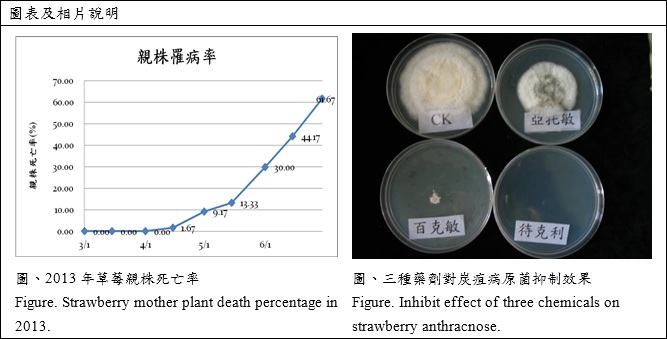- The introduction of biological control
- Establishment of farmer's operational evaluation criteria in the early stage of IPM introduction - taking Miaoli strawberry farmers as an example
- Effects of temperature on parasitism of egg parasitoid wasps, Anastatus japonicus (Hymenoptera: Eupelmidae), using Antheraea pernyi (Lepidoptera: Saturniidae) eggs as alternative host
- The research of intergrated control technology for diseases and pest insects of strawberry in greenhouse
- Application of predator insect on pest control in greenhouse
- Study of storage technology of natural enemies for insect commodity
- Studies on the control for tomato russet mite. 【classified project】
- Development and utilization of mass rearing techniques in natural enemies
- The investigation of biomaterials on preventing crop diseases~ Blumea balsamifera extract
- Application of intergrated control technology for diseases and pest insects in strawberry
- The improvement of propagation techniques on parasitoid and predatory natural enemies
- Studies of anti-stress environment on predator and parasitoid natural enemies insect
- The investigation of biomaterials on preventing crop diseases~ Sapindus mukorossi extract
- The establishment of biocontrol model on diseases and pests in organic tomato【classified project】
- The study of U.S. Department of Agriculture -Pacific Basin Agricultural Research Center(USDA-PBARC)
- Appilication of intergrated control technology for diseases and pest insects in strawberry
- The improvement of propagation techniques on parasitoid and predatory natural enemies
- Studies of anti-stress environment on predatism and parasitism natural enemy insects【classified project】
- The investigation of biomaterials on preventing crop diseases~ Citrus extracts
- The establishment of biocontrol model on diseases and pests in organic tomato
- Application of natural enemies on insect pests of organic vegetables and fruits
- The appilication of intergrated control technology in strawberry disease and pest insects
- The propagation techniques and improvement of Parasitoid and Predatory natural enemies
- The Investigation of Exotic Invading Plants
- Application of natural enemies on insect pests of organic vegetables and fruits
- Application and establishment of integrated management for harmful pests on red jujube
- The investigation of exotic invading plants
- The collection, conservation and setup of gene bank of endemic orchids and fragrant plants in Taiwan
 Home > Recent Research > Biological Control Branch Station > Application of intergrated control technology for diseases and pest insects in strawberry Home > Recent Research > Biological Control Branch Station > Application of intergrated control technology for diseases and pest insects in strawberry
|
Application of intergrated control technology for diseases and pest insects in strawberry
Date:2014-06-17
Healthy seedlings are the foundation of successful strawberry cultivation. In recent years, an epidemic of the strawberry Anthracnose affect strawberry cultivation area that increase farmers' production costs. Our project used the seedbed that had got diseases last year to carry out nursing experiment. The result showed that seedlings grew normally in early stage and began to grow vines in mid-April. The mother plant started to die in early May because the root cap was infected by Anthracnose. The death rate reached 30% in early June and had reached 61.67% in the end of June. the strawberry were also covered with Anthracnose spot on runner. This nursery was not suitable for nursing seedlings any more. Using recommended chemicals in recent years to inhibit anthrax pathogen. The three chemicals pharmacies includes difenoconazole, pyraclostrobin and azoxystrobin as recommended control chemicals for Anthracnose were conducted with 3000x, 1500x and 1000x under 25℃ and 12hr in potato dextrose agar cultivation for two weeks.
The results showed that difenoconazole in three different concentrations were all have significantly inhibitory effect. Farmers usually use azoxystrobin, but its antibacterial effect was not effective. The 1000 times of concentration its plaque diameter under 1000x of azoxystrobin was similar to the control. Pyraclostrobin have bacteriostatic effect, but its effect is weaker than that of difenoconazole. The higher concentration of difenoconazole was more antibacterial effect than that of the lower concentrations.

